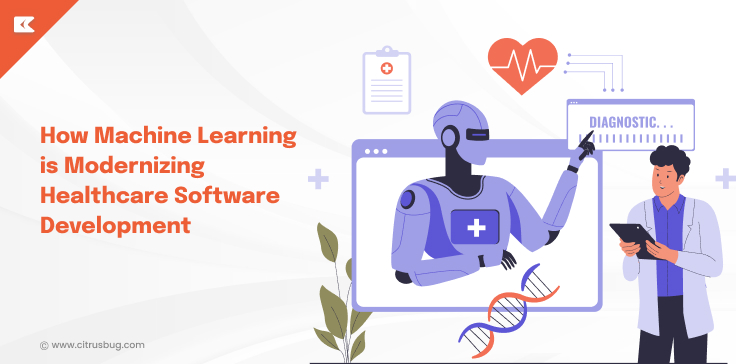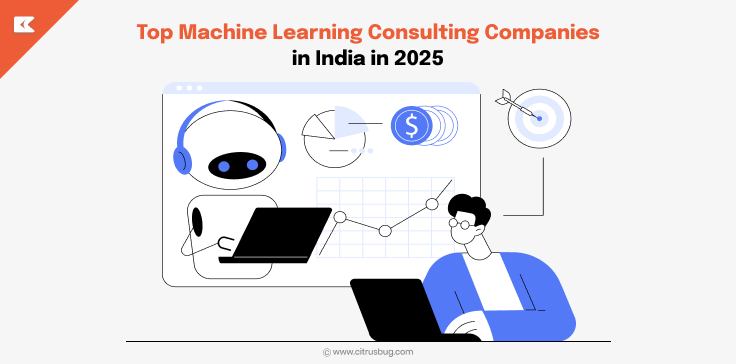Machine Learning Statistics (2025): Market Share & Key Trends
- August 15, 2024
-
4322 Views
- by Ishan Vyas
Table of Contents
- What Is Machine Learning?
- Machine Learning Statistics: Market Size, Share, Growth, and Trends
- Machine Learning Adoption Statistics Across Industries
- ML Statistics That Highlight Business Benefits and Impact
- Sales and Marketing Enhancement Statistics of ML
- Employment and Skill Demand Stats of ML
- ML Statistics Focusing on Challenges & Limitations
- Machine Learning Stats for Future Projections & Trends
- Conclusion
Machine learning (ML) has emerged as a game-changer in diverse fields, giving business operations a fresh new look and opening up exciting new paths for creativity and efficiency. In 2024, it is important to grasp key figures that underscore the expansion, uptake, and influence of machine learning across varied sectors. This piece explores Machine Learning Statistics, providing an all-encompassing snapshot of the machine learning scenario in 2024.
What Is Machine Learning?
Machine learning (ML) is a significant area of artificial intelligence (AI) that uses statistical models and algorithms to let computer systems learn from data and get better at certain tasks. This technique is extensively used in many different fields, including natural language processing and picture and audio recognition. The market for machine learning includes software tools, platforms, and services that make it easier to create and implement machine learning applications.
Key Players
The machine learning market is characterized by two primary performance indicators: overall market size and market size by industry. The overall market size is mostly driven by the funding received by AI companies.
Industry giants like Amazon Web Services, Google Cloud Platform, and Microsoft Azure are the prominent players. These companies provide extensive ML development services. They have become increasingly popular due to their scalability and accessibility.
Several key trends are currently defining the machine learning landscape. A significant trend is the emergence of deep learning, a machine learning subset that utilizes deep networks to analyze diverse data types. Deep learning has demonstrated exceptional effectiveness in tasks involving image and speech recognition, helping in precise predictions and decision-making processes.
The development of new ML algorithms to improve the precision and effectiveness of machine learning models is a significant trend that goes hand in hand with deep learning. More precise and dependable outcomes are made possible by these developments, and these are essential for applications in important industries including healthcare, banking, and retail. For instance, machine learning algorithms are used in banking for risk management and deceit detection, and in healthcare for diagnostics and individualized therapy.
Machine Learning Statistics: Market Size, Share, Growth, and Trends
- Market Expansion and Revenue: In the past few years, the machine learning market has grown at an exponential rate. By 2030, the market would generate $503.40 billion in sales as compared to $4.38 billion in 2021. Because machine learning technologies are being rapidly adopted and integrated across many sectors, this represents an almost 400% rise over the course of six years.
- Research and Development Adoption: In the field of research and development, machine learning and data science are being used at an astounding 71% rate. This high rate of adoption points to a major change in the direction of using data-driven insights to promote innovation and advance science.
- Funding and Investment: In 2019, system applications designed by machine learning raised $28.5 billion in funding. Additionally, machine learning platforms require about 14.4 billion dollars in funding. These figures highlight the substantial financial backing and investor confidence in machine learning technologies.
- Budget Increases: Machine learning increased by at least 25% between 2020 and 2021, indicating the increasing awareness of its importance.
Machine Learning Adoption Statistics Across Industries
- Cybersecurity: About 70% of businesses are now using machine learning to stop cyber-crime. This shows how important machine learning has become in making cybersecurity better and keeping sensitive data safe.
- Business Analysis and Security: In 2018, machine learning was specifically adopted to offer better analysis of problems, with security being another vital reason for its integration into business technologies.
- Predictive Text and Route Suggestions: Since 2017, about 39% of people in Australia who use smartphones have been using predictive text, which is a simple way that machine learning is used. Also, around 20% of these smartphone users in Australia used suggestions for directions in 2017. These statistics highlight the pervasive nature of machine learning in everyday applications.
ML Statistics That Highlight Business Benefits and Impact
- Cost Reduction and Customer Service: A third of firms report improved customer service outcomes as a result of implementing machine learning technologies, and about 38% of enterprises utilize machine learning to save costs. These advantages highlight the improved customer experiences and efficiencies that machine learning can offer.
- Fraud Detection and Prevention: Around 27% of companies have successfully leveraged machine learning to identify and eliminate fraudulent activities, showcasing the technology’s potential in enhancing financial security and integrity.
- Entertainment Industry: ML has significantly enhanced the entertainment industry. A prime example is Netflix, which managed to save $1 billion. This was achieved through machine learning algorithms to customize content, thereby boosting user interaction.
- Healthcare Applications: During the COVID-19 pandemic, machine learning achieved an accuracy rate of 92% in predicting infected patients showing its potential in transforming healthcare diagnostics and treatment planning.
Sales and Marketing Enhancement Statistics of ML
- Sales Efficiency: Machine learning has dramatically improved sales processes, with an estimated 80% of businesses reporting increased revenues due to its implementation. Additionally, there is a potential 60% reduction in customer acquisition costs.
- Customer Insights: Approximately 57% of customers expect companies to anticipate their needs before communication, indicating the importance of machine learning in enhancing personalizing marketing efforts.
- Voice Assistants and Predictive Analytics: It is anticipated that 8 billion people worldwide will be using machine learning-powered voice assistants by the end of the following year. This broad application displays the increasing reliance on machine learning to improve user experiences.
Employment and Skill Demand Stats of ML
- Job Market for Data Scientists: 98,000 job listings in 2020 required expertise of machine learning, indicating the growing demand for machine learning skills. Furthermore, the number of job openings for data scientists increased by 650% between 2011 and 2019, indicating the rising demand for AI skills.
- Impact on Employment: While AI models have displaced 1.8 million jobs, they are expected to produce over 2.3 million new positions. This change demonstrates machine learning’s transformational potential for changing the job sector.
- Salaries for Data Scientists: The high demand for and value placed on machine learning professionals is reflected in the $120,000 average salary for data scientists in the US.
ML Statistics Focusing on Challenges & Limitations
- Data Quality and Scientist Availability: The primary challenges faced by businesses in implementing machine learning include poor data quality (43%), the quest to find qualified data scientists (33%), and a lack of data (38%). These limitations underscore the need for improved data management and talent acquisition strategies.
- Model Accuracy and Validation: Only about 40% of businesses regularly check the accuracy of their machine learning models, highlighting the need for better validation practices to ensure reliable outcomes.
- Alignment and Scaling: Achieving alignment across the organization (34%), scaling (43%), and envisioning future models (41%) are identified as significant limitations to machine learning implementation. Addressing these challenges is important for maximizing the potential benefits of machine learning technologies.
Machine Learning Stats for Future Projections & Trends
- Economic Contribution: Predictions show machine learning and AI contributing 14% to global GDP. This signifies their substantial economic influence. In around 10 years,a 38% surge in business profits is expected. This will add an amount of $14 trillion into the world economy.
- Patent Ownership: With thousands of patents to their names, corporations like NTT, Microsoft, and IBM have been at the forefront of machine learning innovation. Given the fierce rivalry and quick progress in the field of machine learning, IBM had more than 55% of the patents in this domain in 2020.
- Retail and E-commerce: ML has played a significant role in the changes that the retail business is experiencing. An increasing number of retailers—31% in 2018—are using machine learning to enhance their operations in an effort to obtain a competitive edge through insights derived from data.
- Voice-Activated Applications: Given that 51% of consumers say they prefer applications run by command, it is expected that the use of these applications in cars would rise. This pattern displays how machine learning is increasingly being used to improve user experiences in various sectors.
Challenges and Future Prospects
Despite the promising growth, the machine learning market faces several challenges. A significant hurdle is the shortage of skilled talent. Creating and using good machine learning models needs special skills and knowledge, and right now, we don’t have enough people who can do this. Also, worries about keeping data private and safe could slow down how quickly machine learning technologies are being used everywhere.
In summary, Machine learning is a fast-changing area with a lot of promise for many different kinds of businesses. The fact that we have more data than ever, better computers, and a big push for automation are all helping this market grow. But, we need to find more experts and take care of data privacy to really get all the good stuff out of machine learning.
Conclusion
The numbers and trends we’ve discussed in this article sheds light on how the world of machine learning looks like in 2024. From significant market growth and popularity across industries to big benefits in business operations and customer service, machine learning continues to drive innovation and efficiency. However, there are few challenges like data quality and talent acquisition which are to be addressed to fully utilize the potential of machine learning.
As businesses and industries start accepting machine learning, its impact will become increasingly visible. By keeping up with the latest trends and using information from data, companies can use machine learning to grow, work more efficiently, and keep up with changes in technology.
If you are looking to navigate these changes effectively, seeking expert guidance can be beneficial. By getting machine learning consulting services from professionals in the field, companies can better manage data complexities and implement advanced algorithms, ensuring they stay at the forefront of innovation.





 SaaS Development
SaaS Development Web Application Development
Web Application Development Mobile Application Development
Mobile Application Development Custom Software Development
Custom Software Development Cloud Development
Cloud Development DevOps Development
DevOps Development MVP Development
MVP Development Digital Product Development
Digital Product Development Hire Chatbot Developers
Hire Chatbot Developers Hire Python Developers
Hire Python Developers Hire Django Developers
Hire Django Developers Hire ReactJS Developers
Hire ReactJS Developers Hire AngularJS Developers
Hire AngularJS Developers Hire VueJS Developers
Hire VueJS Developers Hire Full Stack Developers
Hire Full Stack Developers Hire Back End Developers
Hire Back End Developers Hire Front End Developers
Hire Front End Developers AI Healthcare Software Development & Consulting
AI Healthcare Software Development & Consulting Healthcare App Development
Healthcare App Development EHR Software Development
EHR Software Development Healthcare AI Chatbot Development
Healthcare AI Chatbot Development Telemedicine App Development Company
Telemedicine App Development Company Medical Billing Software Development
Medical Billing Software Development Fitness App Development
Fitness App Development RPM Software Development
RPM Software Development Medicine Delivery App Development
Medicine Delivery App Development Medical Device Software Development
Medical Device Software Development Patient Engagement Software Solutions
Patient Engagement Software Solutions Mental Health App Development
Mental Health App Development Healthcare IT Consulting
Healthcare IT Consulting Healthcare CRM Software Development
Healthcare CRM Software Development Healthcare IT Managed Services
Healthcare IT Managed Services Healthcare Software Testing services
Healthcare Software Testing services Medical Practice Management Software
Medical Practice Management Software Outsourcing Healthcare IT Services
Outsourcing Healthcare IT Services IoT Solutions for Healthcare
IoT Solutions for Healthcare Medical Image Analysis Software Development Services
Medical Image Analysis Software Development Services Lending Software Development Services
Lending Software Development Services Payment Gateway Software Development
Payment Gateway Software Development Accounting Software Development
Accounting Software Development AI-Driven Banking App Development
AI-Driven Banking App Development Insurance Software Development
Insurance Software Development Finance Software Development
Finance Software Development Loan Management Software Development
Loan Management Software Development Decentralized Finance Development Services
Decentralized Finance Development Services eWallet App Development
eWallet App Development Payment App Development
Payment App Development Money Transfer App Development
Money Transfer App Development Mortgage Software Development
Mortgage Software Development Insurance Fraud Detection Software Development
Insurance Fraud Detection Software Development Wealth Management Software Development
Wealth Management Software Development Cryptocurrency Exchange Platform Development
Cryptocurrency Exchange Platform Development Neobank App Development
Neobank App Development Stock Trading App Development
Stock Trading App Development AML software Development
AML software Development Web3 Wallet Development
Web3 Wallet Development Robo-Advisor App Development
Robo-Advisor App Development Supply Chain Management Software Development
Supply Chain Management Software Development Fleet Management Software Development
Fleet Management Software Development Warehouse Management Software Development
Warehouse Management Software Development LMS Development
LMS Development Education App Development
Education App Development Inventory Management Software Development
Inventory Management Software Development Property Management Software Development
Property Management Software Development Real Estate CRM Software Development
Real Estate CRM Software Development Real Estate Document Management Software
Real Estate Document Management Software Construction App Development
Construction App Development Construction ERP Software Development
Construction ERP Software Development









